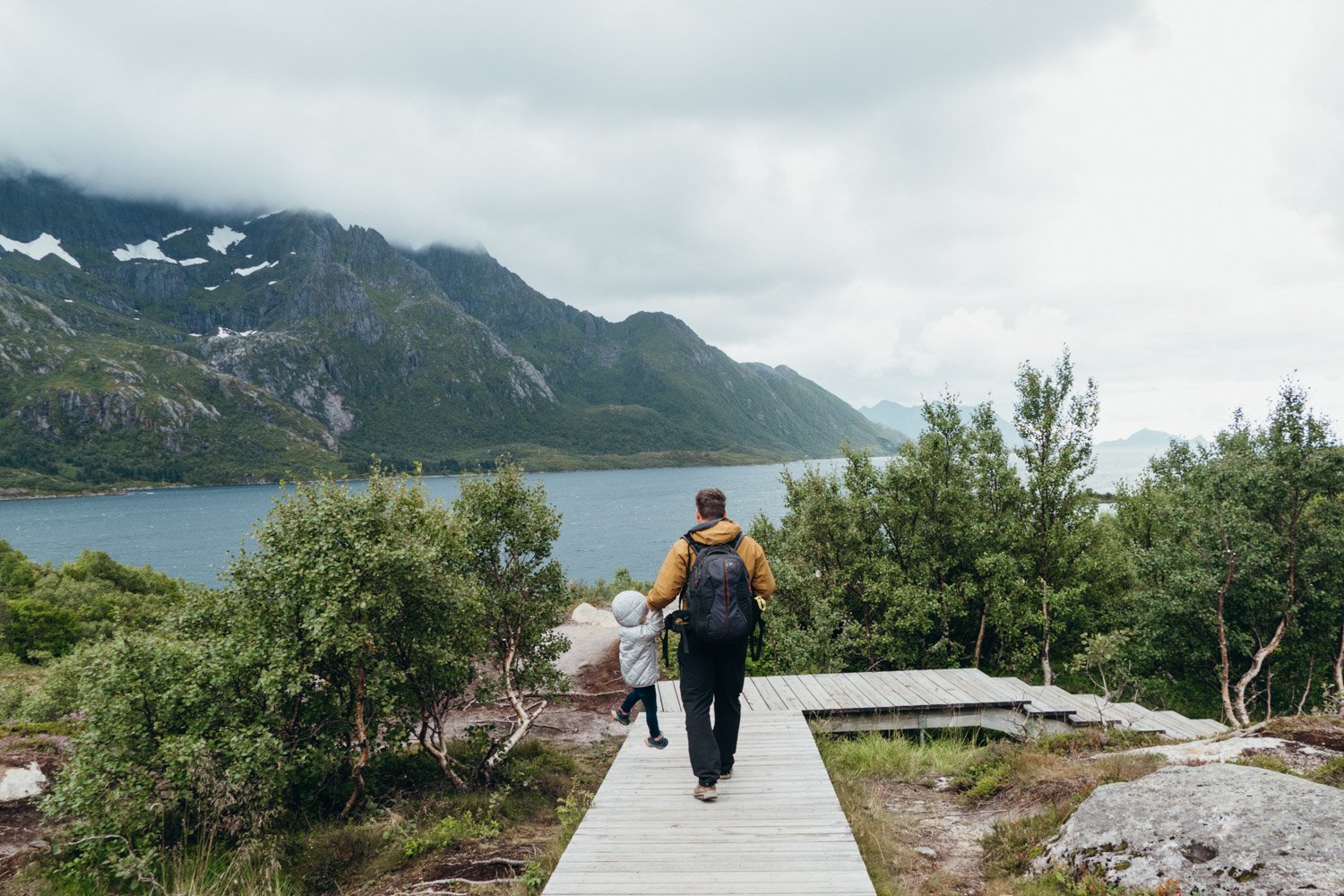7 Ways Families Can Travel More Sustainably
It’s possible! From visiting lesser-known places to prioritizing locally-owned, here are our top tips for how families can travel more sustainably.
For the past almost-decade, our family has traveled to many corners of the planet. Through my husband’s work as a travel photographer (as well as a generous European school holiday schedule), we’ve had the chance to travel often together, from camping in Namibia to road-tripping across Scandinavia, all with our young kids in tow.
True, it’s my husband’s job, but our family has undeniably benefitted from being able to come along with him. But as we move further into the 2020s, we’re grappling with the massive effects of a changing planet— climate change, shifting resources and a tremendous loss of biodiversity— it’s more important than ever for families to travel in a way that not only allows future generations to travel, too, but also contributes to bettering the planet.
Although we’ve always tried to travel as responsibly as possible— visiting lesser-known destinations, supporting locally-owned establishments, and packing more minimally— we’ve discovered so many other ways to make a lasting, positive impact on the places we visit.
But first, what is sustainable travel?
In it’s simplest form, sustainable travel actively contributes to the well-being of environment, nature, and people. This means making a minimum impact on the places we visit, supporting local communities, surrounding landscapes and wildlife, and in an ideal world, helping improve a place long after we’ve left.
The philosophy is trending, too. Gen Z wants to travel more sustainably and give back to the communities they visit, and Millenials, many of whom have families of their own, are also equally as conscious about it. It’s important for families with young children to start instilling sustainable practices (both abroad and at home) so they can not only have a more meaningful travel experience, but ideally be a part of the solution.
We are raising the future generations who have power to completely transform what travel— and our world— can look like. Below are some foundational things we consider to make our travels more sustainable:
Keep it Local
According to the UN’s World Tourism Organization, just 5% of money spent by tourists actually stays in the communities they visit. There’s a term the travel industry uses – ‘leakage’ – which describes how travelers’ spending leaks out of host countries and into the pockets of multinational corporations.
But there are ways travelers can easily plug these leaks— by prioritizing locally owned restaurants, hotels or homestays, engaging local (and female) guides, and purchasing handmade goods and products that support artisans from the direct community— we can ensure that we are actively contributing to the place we visit.
Tip: Spread the wealth. Eat in different restaurants, use different guides, buy souvenirs from different artisans throughout your stay. This type of intentional tourism can be one of the best distributions of wealth and puts money directly into local families.
2. Our Carbon Footprints
The EPA notes that 30% of CO2 emissions are attributed to the transportation industry at large, and if taking a long-haul flight isn’t carbon intensive enough for one person, multiply that by how many family members you have. It’s a big dent, especially considering the small percentage of people who even have the privilege of flying.
Yet there’s a host of ways to reduce our impact as we move towards a more sustainable aviation future. We can reduce our flights overall by prioritizing trains, ferries and other modes of transport, we can search our flights by emissions before we book them (while Google Flights has been accused of airbrushing its results, booking platform Kayak does work with Atmosfair for transparency), and we can offset. Offsetting isn’t a silver bullet, but it does empower travelers to think outside the box. By joining a climate collective like Tomorrow’s Air or contributing to one of many great reforestation and rewilding projects out there, it also sparks curiosity in our kids about how we can integrate more with our travels.
3. Get Off-the-Beaten Path
Our world is more connected than ever— with the hypersaturation of geotagged content for the ‘gram to a universally wealthier global population keen on exploring the world, travel is here to stay. That’s why it’s so important we choose wisely where we tread.
Traveling in the off-or-shoulder season, visiting alternative or “second” cities and forging unique routes like visiting UNESCO World Heritage sites are all chances to support a place which has been often overlooked, and they offer so much as far as education and enrichment of a place.
By visiting these lesser-discovered destinations and communities instead, it allows us to stay away from the crowds an directly and infuse our goodness in other parts of a country.
4. Be Mindful of the People, Places + Animals We Visit
One of the most important aspects of sustainable travel is building a relationship with the people you meet along the way based on respect, open-mindedness and mutual exchange. Every site, meal, activity or interaction of any kind offers an opportunity to foster these relationships and build a deeper cultural understanding.
Before a trip, we always do a bit of homework— open up a map, show our kids videos, learn a few words in the language of our host country, as well as the culture’s etiquette.
When we’re there, we make an extra effort to linger around public spaces to open ourselves up to new conversations and connections. With regards to art, music and cultural performance, treat any expression of someone’s culture as absolutely sacred and gift they are giving of themselves to you. Many of these practices and traditions will fall by the wayside over the next decades, and tourism does help keep these traditions alive.
The same goes for animals: when planning for interacting with wildlife, make sure the host organization is committed to humane, non-disruptive, eco-friendly practices. Catch-and-release aquariums and animal sanctuaries are often good places to start.
There’s also ways to help actively improve the place you’re visiting. Local beach clean-ups, citizen science and rewilding projects are just a few of the types of activities that can get the whole family involved and excited about being there.
Overall, the opportunities for connection on a local level are endless. Cooking classes, arts and crafts workshops, local festivals, and the list goes on. Just enjoy what each community has to offer, stay curious and informed, and give back whenever and however possible.
5. Slow it Down
Taking fewer, but longer and slower, journeys is another way to travel more consciously, giving us the time and space to more deeply understand destinations. That might mean picking one place, not four, to visit in a week; considering off-season travel when there are fewer crowds; cramming less into our itineraries so we can keep ourselves open to discovery – this is how we make our journeys more satisfying. Slower travel also serves as an antidote to our warp-speed modern world, helping to return us to a more human pace and soothing our frayed nervous systems, while giving us the opportunity to make a bigger economic impact on communities.
6. Pack light, travel green
The way we travel can influence the way we live, but the opposite can also be said. To avoid single-use plastic waste, bring your own reusable products from home: all-purpose totes, napkins, straws, utensils and catch-all storage solutions. Here are a few of our favorites. A reusable bottle is, of course, a must. You can also bring along a filtered water bottle like Larq or GRAYL that allows you to lets you filter and purify your water along the way.
Streamline packing by sticking to a capsule wardrobe and use packing cubes to keep everything organized. Pack your own toiletries in reusable travel-sized containers, but if you have to throw something away, ask about your lodging’s recycling program. Overall, less luggage means increased flexibility, higher fuel efficiency and ultimately a lower carbon footprint.
And check out ahead of time if your hotel is not only locally-owned, but if it has good environmental and social practices. Mainstream booking platforms like Booking.com are taking steps with travel sustainable filters that check these practices.
7. Actively Practice Regeneration and Sustainability
Travel can expand our horizons, release stress and introduce new inspiration to our lives. But what happens when we take it one step further and consider how our travels can benefit the world around us? We get the opportunity to transform our beliefs into actions, to move beyond the buzzwords of sustainability to instilling healthy, mindful habits in us and our little ones. And this can make all the difference.







